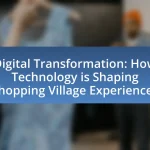Themed shopping villages are specialized retail environments designed around specific themes, offering a unique shopping experience that combines shops, restaurants, and entertainment. These villages differ from traditional retail spaces by creating immersive atmospheres that enhance customer engagement and satisfaction. The article explores the characteristics that define themed shopping villages, the influence of themes on the shopping experience, and the consumer trends driving their popularity. Additionally, it examines the economic impacts of these villages, the challenges they face, and strategies retailers can implement to thrive within them. Emerging trends, including technology integration and sustainability, are also discussed as key factors shaping the future of themed shopping villages.

What are Themed Shopping Villages?
Themed shopping villages are retail environments designed around a specific theme or concept, creating a unique shopping experience for visitors. These villages often feature a combination of shops, restaurants, and entertainment options that align with the chosen theme, enhancing the overall atmosphere and appeal. For example, a themed shopping village may replicate a historical era, a cultural motif, or a natural setting, providing an immersive experience that attracts consumers seeking more than just traditional shopping. The success of themed shopping villages can be seen in their ability to draw foot traffic and foster community engagement, as evidenced by the popularity of locations like the Grove in Los Angeles, which combines shopping with entertainment and dining in a cohesive thematic setting.
How do Themed Shopping Villages differ from traditional retail spaces?
Themed Shopping Villages differ from traditional retail spaces primarily in their immersive environments and curated experiences. Unlike conventional retail, which focuses on individual stores and products, themed shopping villages create a cohesive atmosphere that reflects a specific theme or concept, enhancing customer engagement. For example, many themed shopping villages incorporate architecture, landscaping, and entertainment that align with their theme, fostering a unique shopping experience that encourages longer visits and increased spending. This approach is supported by studies indicating that experiential retail environments can significantly boost customer satisfaction and loyalty, as they provide not just shopping but also leisure and social interaction opportunities.
What unique characteristics define Themed Shopping Villages?
Themed Shopping Villages are defined by their immersive environments, which create a cohesive narrative or theme that enhances the shopping experience. These villages often feature distinctive architectural styles, curated retail offerings, and themed entertainment that align with a specific concept, such as a historical period or cultural motif. For example, many themed shopping villages incorporate elements like cobblestone streets, decorative facades, and themed signage to transport visitors into a different world, thereby increasing customer engagement and dwell time. This unique approach not only differentiates them from traditional shopping centers but also fosters a sense of community and experience, making shopping more than just a transactional activity.
How do themes influence the shopping experience?
Themes significantly influence the shopping experience by creating immersive environments that enhance customer engagement and satisfaction. Themed shopping villages, for instance, utilize specific design elements, decor, and curated product selections to evoke particular emotions and narratives, which can lead to increased dwell time and spending. Research indicates that environments designed around cohesive themes can improve customer perception of value and brand loyalty, as shoppers feel a stronger connection to the experience. A study published in the Journal of Retailing found that thematic consistency in retail settings positively affects consumer behavior, leading to higher purchase intentions and overall enjoyment of the shopping experience.
Why are Themed Shopping Villages becoming popular?
Themed shopping villages are becoming popular due to their ability to offer unique and immersive retail experiences that attract consumers seeking more than just traditional shopping. These environments often combine shopping with entertainment, dining, and cultural experiences, creating a destination rather than a mere retail space. For instance, themed shopping villages often feature architecture and decor that reflect specific themes, enhancing the overall atmosphere and encouraging longer visits. This trend is supported by consumer preferences for experiential shopping, as evidenced by a 2021 report from the International Council of Shopping Centers, which found that 72% of consumers prefer shopping destinations that provide experiences beyond just purchasing products.
What consumer trends are driving the rise of Themed Shopping Villages?
The rise of Themed Shopping Villages is primarily driven by consumer trends favoring experiential retail and personalization. Consumers increasingly seek unique and immersive shopping experiences that go beyond traditional retail, leading to a demand for environments that offer entertainment, social interaction, and a sense of community. According to a report by the International Council of Shopping Centers, 72% of consumers prefer shopping destinations that provide experiences, indicating a shift towards venues that combine shopping with leisure activities. Additionally, the trend of personalization has led retailers to create themed environments that cater to specific interests and lifestyles, enhancing customer engagement and loyalty.
How do Themed Shopping Villages enhance customer engagement?
Themed shopping villages enhance customer engagement by creating immersive environments that encourage exploration and interaction. These villages often feature unique architectural designs, themed decor, and curated experiences that resonate with specific interests or lifestyles, making shopping feel more like an adventure. For instance, research indicates that environments designed with a strong theme can increase customer dwell time by up to 30%, leading to higher sales and customer satisfaction. Additionally, themed events and activities, such as seasonal festivals or workshops, foster community involvement and repeat visits, further solidifying customer loyalty.

What role do Themed Shopping Villages play in curating unique retail experiences?
Themed Shopping Villages play a crucial role in curating unique retail experiences by creating immersive environments that enhance consumer engagement. These villages often feature distinct architectural styles, themed decor, and curated product offerings that align with a specific concept or lifestyle, making shopping more than just a transactional activity. For example, a themed shopping village may replicate a historical village or a coastal town, providing visitors with a sensory experience that includes sights, sounds, and tastes reflective of that theme. This approach not only attracts customers seeking novelty but also fosters a sense of community and belonging, as shoppers often return for the atmosphere and events hosted within these spaces. Research indicates that such environments can increase dwell time and spending, as consumers are more likely to explore and enjoy their shopping experience in a well-designed thematic setting.
How do Themed Shopping Villages create immersive environments?
Themed Shopping Villages create immersive environments by integrating cohesive design elements, thematic architecture, and interactive experiences that engage visitors. These villages often feature distinct architectural styles and decor that reflect a specific theme, such as Mediterranean or Victorian, which enhances the visual appeal and transports shoppers into a different world. Additionally, they incorporate sensory elements like music, scents, and lighting that align with the theme, further deepening the immersive experience. For example, a themed shopping village designed around a coastal theme may use ocean sounds and nautical decor to evoke a seaside atmosphere. This strategic combination of visual and sensory stimuli not only attracts visitors but also encourages longer stays and increased spending, as evidenced by studies showing that immersive environments can enhance consumer engagement and satisfaction.
What elements contribute to the immersive experience in Themed Shopping Villages?
The immersive experience in Themed Shopping Villages is primarily contributed by thematic architecture, interactive elements, sensory engagement, and curated entertainment. Thematic architecture creates a cohesive environment that transports visitors into a different world, often reflecting specific cultural or historical themes. Interactive elements, such as hands-on displays or augmented reality features, engage visitors actively, enhancing their connection to the space. Sensory engagement, including carefully designed lighting, soundscapes, and scents, stimulates the senses and deepens the immersive experience. Curated entertainment, such as live performances or themed events, provides dynamic experiences that draw visitors in and encourage longer stays. These elements collectively create a unique atmosphere that differentiates Themed Shopping Villages from traditional retail environments.
How does storytelling enhance the shopping experience in these villages?
Storytelling enhances the shopping experience in themed villages by creating an immersive environment that engages customers emotionally. This emotional engagement fosters a deeper connection to the products and the overall shopping experience, making it more memorable. For instance, themed villages often incorporate narratives related to local culture, history, or craftsmanship, which can increase customer interest and encourage purchases. Research indicates that consumers are more likely to buy products when they feel a personal connection to the story behind them, as evidenced by a study from the Journal of Consumer Research, which found that storytelling can significantly influence purchasing decisions by enhancing perceived value and authenticity.
What are the economic impacts of Themed Shopping Villages?
The economic impacts of Themed Shopping Villages include increased local employment, enhanced tourism revenue, and stimulated regional economic growth. These shopping villages attract visitors seeking unique retail experiences, which boosts sales for local businesses and creates job opportunities in retail, hospitality, and services. For instance, a study by the International Council of Shopping Centers found that themed retail environments can increase foot traffic by up to 30%, leading to higher sales volumes. Additionally, themed shopping villages often contribute to infrastructure development and urban revitalization, further benefiting the local economy.
How do Themed Shopping Villages contribute to local economies?
Themed Shopping Villages contribute to local economies by attracting tourists and increasing consumer spending. These villages create unique shopping experiences that differentiate them from traditional retail environments, leading to higher foot traffic. For instance, a study by the International Council of Shopping Centers found that themed retail destinations can generate up to 30% more sales per square foot compared to conventional malls. Additionally, they often create jobs in retail, hospitality, and services, further stimulating local employment rates. The presence of themed shopping villages can also enhance local property values and encourage investment in surrounding areas, thereby fostering overall economic growth.
What are the potential challenges faced by Themed Shopping Villages?
Themed Shopping Villages face several potential challenges, including market saturation, high operational costs, and changing consumer preferences. Market saturation occurs when too many similar themed shopping experiences compete for the same customer base, leading to diminished foot traffic and sales. High operational costs arise from maintaining unique themes, which often require specialized staff, decor, and marketing efforts. Additionally, changing consumer preferences can impact the relevance of themes, as shoppers increasingly seek diverse and authentic experiences rather than standardized offerings. These challenges necessitate strategic planning and adaptability to remain competitive in the retail landscape.

How can retailers effectively utilize Themed Shopping Villages?
Retailers can effectively utilize Themed Shopping Villages by creating immersive experiences that align with the village’s theme, thereby enhancing customer engagement and driving sales. By designing stores and experiences that reflect the overarching theme—such as a specific culture, historical period, or lifestyle—retailers can attract visitors seeking unique shopping experiences. For instance, themed events, seasonal festivals, and interactive installations can draw foot traffic and encourage longer visits. According to a study by the International Council of Shopping Centers, 72% of consumers prefer shopping in environments that offer unique experiences, highlighting the importance of thematic alignment in attracting customers.
What strategies can retailers implement to thrive in Themed Shopping Villages?
Retailers can thrive in Themed Shopping Villages by creating immersive experiences that align with the village’s theme. This involves designing stores that reflect the thematic elements, offering exclusive products that resonate with the theme, and hosting events that engage visitors. For instance, a themed shopping village centered around a coastal vibe can feature nautical decor, beachwear, and surf-related activities, attracting customers who are drawn to that lifestyle. Additionally, leveraging social media to promote these unique experiences can enhance visibility and attract a broader audience, as evidenced by studies showing that 70% of consumers are influenced by social media when making purchasing decisions.
How can retailers align their brand with the village’s theme?
Retailers can align their brand with the village’s theme by integrating their product offerings, store design, and marketing strategies to reflect the village’s unique characteristics and cultural elements. For instance, if the village emphasizes artisanal craftsmanship, retailers should focus on sourcing locally made products and showcasing them in a way that highlights their origin and craftsmanship. This approach not only resonates with the village’s identity but also attracts customers who value authenticity and local culture. Additionally, retailers can participate in village events and collaborate with local artisans, further embedding their brand within the community’s theme and enhancing customer engagement.
What role does collaboration play among retailers in Themed Shopping Villages?
Collaboration among retailers in Themed Shopping Villages enhances customer experience and drives foot traffic. By working together, retailers can create a cohesive theme that attracts visitors, encouraging them to explore multiple stores within the village. For instance, joint marketing efforts and shared events can amplify visibility and create a unique shopping atmosphere that differentiates the village from traditional retail spaces. Research indicates that themed environments can increase consumer spending by up to 30%, demonstrating the effectiveness of collaboration in creating engaging retail experiences.
What best practices should retailers follow in Themed Shopping Villages?
Retailers in Themed Shopping Villages should prioritize creating immersive experiences that align with the village’s theme. This involves designing stores that reflect the overall aesthetic and narrative of the shopping environment, enhancing customer engagement. For instance, retailers can utilize thematic decor, staff uniforms, and product displays that resonate with the village’s concept, fostering a cohesive atmosphere.
Additionally, offering unique, themed products can attract visitors and encourage purchases. Research indicates that themed environments can increase customer dwell time and spending, as consumers are drawn to experiences that resonate with their interests and emotions. Furthermore, retailers should collaborate with other businesses within the village to create cross-promotional events, enhancing foot traffic and community engagement.
Implementing these best practices can lead to increased customer satisfaction and loyalty, ultimately driving sales in Themed Shopping Villages.
How can retailers enhance customer experience through events and activities?
Retailers can enhance customer experience through events and activities by creating immersive and engaging experiences that foster community interaction and brand loyalty. For instance, hosting themed events, such as seasonal festivals or product launches, allows customers to connect with the brand in a memorable way. According to a study by Eventbrite, 78% of consumers prefer to spend money on experiences rather than material goods, highlighting the importance of experiential marketing. Additionally, incorporating interactive elements, such as workshops or live demonstrations, can further engage customers, making them feel more invested in the brand. This approach not only increases foot traffic but also encourages repeat visits, ultimately driving sales and customer satisfaction.
What marketing strategies are most effective for promoting Themed Shopping Villages?
The most effective marketing strategies for promoting Themed Shopping Villages include experiential marketing, social media engagement, and partnerships with local businesses. Experiential marketing creates immersive experiences that attract visitors, as evidenced by the success of themed events that draw large crowds. Social media engagement leverages platforms like Instagram and Facebook to showcase unique offerings and events, with studies indicating that 54% of consumers use social media to research products before purchasing. Additionally, partnerships with local businesses enhance community involvement and drive foot traffic, as seen in successful collaborations that increase visibility and attract diverse customer bases.
What are the future trends for Themed Shopping Villages?
The future trends for themed shopping villages include increased integration of technology, enhanced experiential offerings, and a focus on sustainability. Themed shopping villages are expected to adopt augmented reality and virtual reality to create immersive shopping experiences, allowing customers to engage with products in innovative ways. Additionally, there will be a shift towards creating unique, interactive events and activities that draw visitors, such as live performances and workshops, which enhance the overall shopping experience. Sustainability will also play a crucial role, with themed shopping villages prioritizing eco-friendly practices, such as using sustainable materials in construction and promoting local artisans. These trends are supported by consumer preferences for personalized and meaningful shopping experiences, as evidenced by a 2022 report from McKinsey, which highlighted that 70% of consumers value experiences over products.
How might technology influence the evolution of Themed Shopping Villages?
Technology will significantly influence the evolution of Themed Shopping Villages by enhancing customer engagement and operational efficiency. Innovations such as augmented reality (AR) and virtual reality (VR) can create immersive shopping experiences, allowing customers to interact with products in a virtual environment, which has been shown to increase consumer interest and sales. For instance, a study by Deloitte found that AR can boost conversion rates by up to 40% in retail settings. Additionally, data analytics and artificial intelligence (AI) can personalize marketing strategies, tailoring promotions and experiences to individual preferences, thereby improving customer satisfaction and loyalty. The integration of mobile payment systems and smart kiosks will streamline transactions and provide real-time information, further enhancing the shopping experience. Overall, these technological advancements will transform Themed Shopping Villages into dynamic, interactive spaces that cater to modern consumer expectations.
What emerging themes are likely to shape future shopping experiences?
Emerging themes likely to shape future shopping experiences include personalization, sustainability, and technology integration. Personalization is driven by data analytics, allowing retailers to tailor offerings to individual preferences, enhancing customer satisfaction. Sustainability is increasingly prioritized, with consumers favoring brands that demonstrate eco-friendly practices, such as using sustainable materials and reducing waste. Technology integration, including augmented reality and artificial intelligence, is transforming how consumers interact with products, providing immersive experiences that bridge the gap between online and offline shopping. These themes are supported by market research indicating that 80% of consumers are more likely to purchase from brands that offer personalized experiences, while 66% of global consumers are willing to pay more for sustainable brands.
What practical tips can retailers apply to succeed in Themed Shopping Villages?
Retailers can succeed in Themed Shopping Villages by creating immersive experiences that align with the village’s theme. This involves designing store layouts and product displays that reflect the theme, enhancing customer engagement. For instance, a village themed around a specific culture can feature products and decor that resonate with that culture, making the shopping experience more relatable and enjoyable. Additionally, hosting themed events or workshops can attract foot traffic and foster community involvement, as evidenced by the success of themed festivals that draw large crowds. Retailers should also leverage social media to promote their unique offerings and events, as studies show that 70% of consumers are influenced by social media when making purchasing decisions. By focusing on these strategies, retailers can effectively enhance their presence and sales in Themed Shopping Villages.


